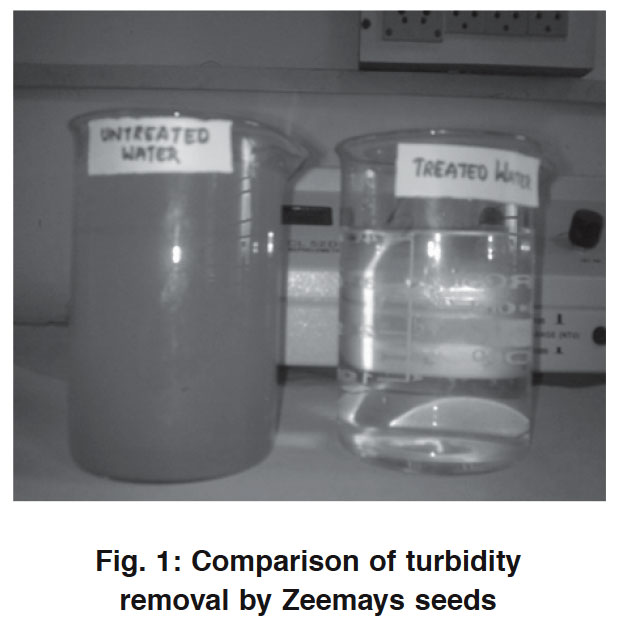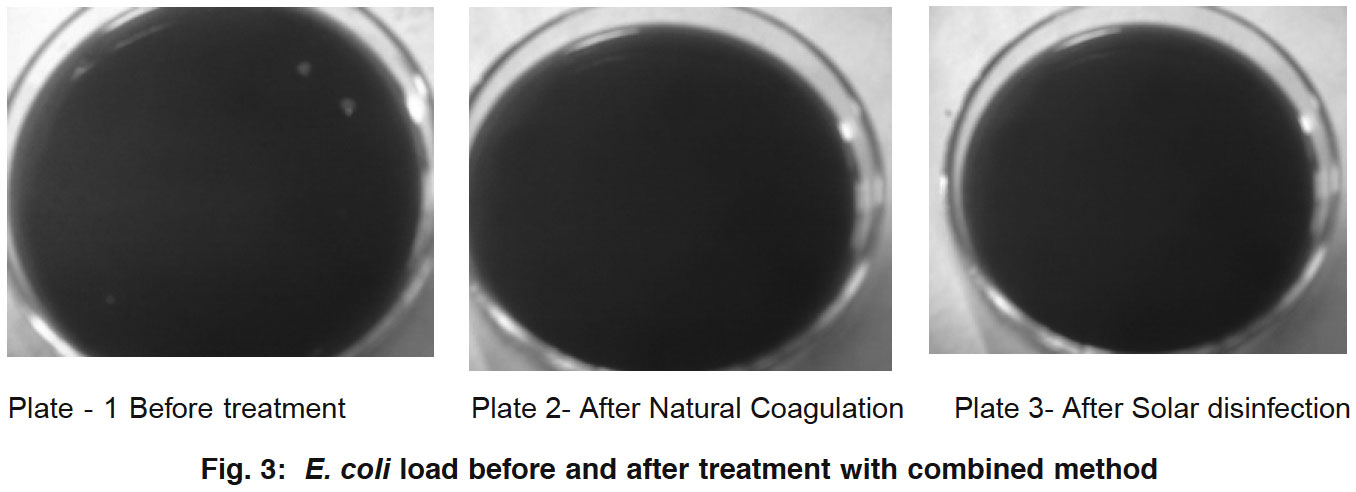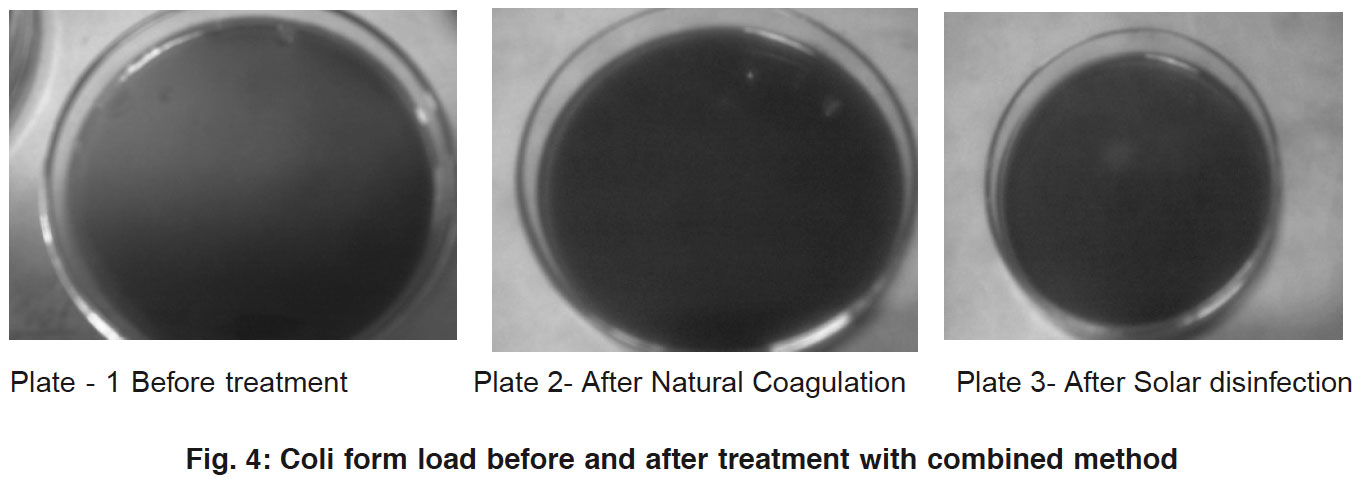Role of natural coagulant and solar energy in treating turbid water
Syeda Azeem Unnisa1 * , Chaitanyakumar Desitti2 and S. Bhupatthi Rao1
1
Regional Centre for Urban and Environmental Studies,
Osmania University,
Hyderabad,
500 007
India
2
JNT University Hyderabad,
500085
India
DOI: http://dx.doi.org/10.12944/CWE.5.2.24
Present study deals with use of indigenous or natural treatment methods using plant material and solar radiation as alternatives to conventional treatment method. The coagulation ability of Zeemays (Maize) extract was assessed by the use of standard jar test measurements in water with various turbidities. Investigation of Zeemays as natural coagulant was confirmed by its positive effective coagulation activity. An optimum dose of 200 mg/l, 220 mg/l and 300 mg/l of this coagulant resulted in 75%, 65% and 70% coagulation activity for clarification of 20 NTU, 40 NTU and 80 NTU water along with inactivation of bacteria in 60 minutes. Further clarified water with natural coagulant was exposed to sunlight which showed 100 % inactivation of both E. coli and Coliforms counts within 2 hr, with no subsequent reactivation of growth after 24 hr.
Copy the following to cite this article:
Unnisa S. A, Desitti C, Rao B. S. Role of natural coagulant and solar energy in treating turbid water. Curr World Environ 2010;5(2):365-368 DOI:http://dx.doi.org/10.12944/CWE.5.2.24
Copy the following to cite this URL:
Unnisa S. A, Desitti C, Rao B. S. Role of natural coagulant and solar energy in treating turbid water. Curr World Environ 2010;5(2):365-368. Available from: http://www.cwejournal.org/?p=1229
Download article (pdf)
Citation Manager
Publish History
Select type of program for download
| Endnote EndNote format (Mac & Win) | |
| Reference Manager Ris format (Win only) | |
| Procite Ris format (Win only) | |
| Medlars Format | |
| RefWorks Format RefWorks format (Mac & Win) | |
| BibTex Format BibTex format (Mac & Win) |
Article Publishing History
| Received: | 2010-10-05 |
|---|---|
| Accepted: | 2010-12-10 |
Introduction
I Surface water contains very high pathogenic microbial contaminants, mainly bacteria and virus, due to animal and organic matter decomposition.1 Intake of the raw water is a high risk for health that affects mainly children and old people.2 Lack of safe drinkable water is a serious problem that affects people from developing countries, conditioning health, social economical development. In fact, people are supplied with water from rivers or surface waters, without any treatment.3
Conventional drinking water treatments are often inappropriate in developing countries, due to its high cost, lack of inappropriate infrastructures or availability of chemicals.4 The combined use of natural coagulants and solar disinfection technology for potabilization could be feasible, effective and workable alternative for potable water treatment.
Material and Methods
Surface water normally contains high turbidity and microbial content, mainly viruses and bacteria that cause illness, such as diarrhea5. Approaches to alleviate this situation are focused on sustainable water treatment, low cost, robust and which require minimal maintenance.6 Natural coagulant and solar disinfection technology when used sequentially is a better method to treat this water and produce safe drinking water. Coagulation technology is based on polyelectrolyte mechanism where quantity of low molecular weight (water soluble proteins) which carry positive charge when added to raw water, the polysaccharide produce positive charge acting like magnets and attract the predominantly negatively charged particles such as silt, clay, bacteria and toxic particles in water.7 Where as solar disinfection is a process of disinfection where organisms are exposed to sunlight, photo sensitizers absorbs photons of light in the UV-A and early visible wave length regions of 320 to 450 nm8. The photo sensitizers react with oxygen molecules to produce highly reactive oxygen species. In turn, these species react with DNA, this leads to strand breakage, which is fatal, base changes, which results in mutagenic effects such as blocks to replicate.9
Experimental works evaluate, identify and compare the coagulation effect of the coagulant extract from Zeemays seeds by using jar test method. This test was performed by measuring turbidity of a sample made of coagulant extract and synthetic turbid water (kaoline clay suspension). After 1 hour of settling, the reduction in absorbance relative to the control defines coagulation activity shown in Figure 1. The results of turbidity reduction with natural coagulant were compared with WHO standards.10 The turbid water clarified with natural coagulant was exposed to solar radiation for disinfection for 5 hours for inactivation of E.coli and Coliforms along with a control. Antimicrobial studies were carried out in agar plate, for untreated and treated samples with natural coagulants and solar disinfection.
Results and Discussion
Results of the treated samples from natural coagulant Zeemays and solar disinfection are shown in Table 1 and 2. Jar test method for natural coagulant (Zeemays) showed high turbidity reduction and high coagulant activity in samples treated as it contain active ingredient starch, which is non-ionic polymer which forms positive and negative ions in water and the mechanisms of coagulation is by bridging shown in Figure 2. Where as water clarified with natural coagulant when exposed to solar disinfection showed drastic inactivation of E.coli and Coliforms in sample treated which is depicted in Figure 3 and 4.
 |
Table 1: Combined treatment of turbid water by natural coagulants and solar disinfection. Click here to View table |
 |
Figure 1: Comparison of turbidity removal by Zeemays seeds. Click here to View figure |
 |
Figure 2: Optimization of Zeemays at different turbidities. Click here to View figure |
 |
Figure 3: E. coli load before and after treatment with combined method. Click here to View figure |
 |
Figure 4: Coli form load before and after treatment with combined method. ​​​​Click here to View figure |
 |
Table 2: Inactivation of bacteria by solar disinfection from water clarified with Zeemays. ​​​​​Click here to View table |
Conclusions
Studies have shown that the combination of natural treatment methods using plant seeds (Zeemays) and solar disinfection indicate that this method can effectively clarify and disinfect household drinking water, so the use of natural coagulants that are locally available in combination with solar radiation, which is abundant and inexhaustible, provides a solution to the need for clean and safe drinking water in the rural communities.
Acknowledgements
The authors thank the Department of Science Technology (DST) who has granted project under Water Initiative Technology, New Delhi.
References
- Ozacar M. and Sengil A., Colloids and Surfaces A: Physicochem. Eng. Aspects. 229: 85-96 (2003).
- Ghebremichael K.A., Gunaratna K. R., Henriksson H. Brumer and Dalhammar G., Water Res. 39: 2338- 2344 (2005).
- Sobsey M. D., Journal of Water Health. 4: 17-21 (2006).
- Lye D. J., J. AWRA. 38: 1301-1306 (2002).
- Berney M., Weilenmann H., Simonetti A. and Egli T., J. App. Micro., 101: 828-836 (2006).
- Kehoe S. C., Barer M. R., Devlin L.O. and Mcguigan, K.G, J. of App. Micro. 38: 410-414 (2004).
- Babu R. and Chaudhuri M., J. Water Health.,3: 27 -30 (2005).
- Tandon P., Chhibber S. and Reed R. H., J. Water Research. 88: 35-48 (2005).
- Fujioka R. S. and Yoneyama B. S., J. Water Science Technology. 46: 291-295 (2002.).
- WHO, Water for Life: making it happens, World Health Organisation, Geneva: Switzerlan, (2005).






